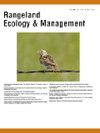Combining Management Techniques for Short-Term Reduction of Introduced Old World Bluestems in South Texas Rangelands
IF 2.4
3区 环境科学与生态学
Q2 ECOLOGY
引用次数: 0
Abstract
Several ecotypes within a group of introduced, warm-season, perennial bunchgrasses labeled Old World Bluestems (OWB) have become invasive throughout much of Texas. Specifically, Kleberg bluestem (Dichanthium annulatum Forssk.) and yellow bluestem (Bothriochloa ischaemum L.) in South Texas have become a dense monoculture that reduces biodiversity of both plants and wildlife while also being poor fodder for domestic livestock. Reduction of Kleberg and yellow bluestem is desired, but there has been limited research on effective combinations of grassland management practices. We conducted two 4 × 5 factorial experiments at six locations across Bee, Kleberg, and San Patricio counties in South Texas. Primary treatments (summer fire, glyphosate and native reseeding, or nicosulfuron + metsulfuron methyl, and a control [no treatment]) were combined with secondary treatments (plowing, plowing and native reseeding, mowing, or fertilization, and a control [no treatment]). In both experiments, herbage mass was not different among primary treatments at any sample collection date, whereas plowed treatments had reduced herbage mass until the spring (Experiment 1) or summer (Experiment 2) after treatments were completed. Plowing reduced canopy cover until the summer after treatment when canopy cover was not different among treatments in both experiments. Among primary treatments, only glyphosate herbicide application reduced canopy cover. All management practices applied in this study either had negative effects or provided only short-term (1–1.5 yr) reduction in OWB. Treatments that were most effective in reducing OWB cover and herbage mass included plowing, mowing, and glyphosate application and were also detrimental to desirable plant species so may not be desirable to land managers. Limited success of treatments applied in this study reinforces the challenge to reduce the invasive tendencies of introduced forage species such as OWB.
联合管理技术短期减少南德克萨斯牧场引进的旧大陆蓝茎
在一组被称为旧世界蓝草(OWB)的引进的暖季多年生束草中,有几种生态类型已经成为德克萨斯州大部分地区的入侵物种。具体来说,南德克萨斯州的Kleberg蓝茎(Dichanthium annulatum Forssk.)和黄蓝茎(Bothriochloa ischaemum L.)已经成为密集的单一栽培,减少了植物和野生动物的生物多样性,同时也成为家畜的不良饲料。减少Kleberg和黄蓝茎是可取的,但对草地管理措施有效组合的研究有限。我们在得克萨斯州南部的比县、克莱伯格县和圣帕特里西奥县的六个地点进行了两次4 × 5的析因实验。初级处理(夏火、草甘膦和本地复种,或硝磺隆 + 甲磺隆和对照[不处理])与二级处理(犁地、犁地和本地复种、刈割或施肥和对照[不处理])相结合。在两个试验中,在任何取样日期,主要处理之间的牧草质量没有差异,而翻耕处理直到处理结束后的春季(试验1)或夏季(试验2)牧草质量都有所减少。耕减冠层盖度直至处理后夏季,两种处理的冠层盖度无显著差异。在主要处理中,只有草甘膦除草剂的施用减少了冠层盖度。本研究中采用的所有管理措施要么有负面影响,要么只提供短期(1-1.5年)的OWB减少。在减少OWB覆盖和牧草质量方面最有效的处理方法包括犁地、割草和草甘膦的施用,这些处理方法也对理想的植物物种有害,因此可能不适合土地管理者。在本研究中应用的有限成功的处理加强了减少引进饲料物种(如OWB)入侵倾向的挑战。
本文章由计算机程序翻译,如有差异,请以英文原文为准。
求助全文
约1分钟内获得全文
求助全文
来源期刊

Rangeland Ecology & Management
农林科学-环境科学
CiteScore
4.60
自引率
13.00%
发文量
87
审稿时长
12-24 weeks
期刊介绍:
Rangeland Ecology & Management publishes all topics-including ecology, management, socioeconomic and policy-pertaining to global rangelands. The journal''s mission is to inform academics, ecosystem managers and policy makers of science-based information to promote sound rangeland stewardship. Author submissions are published in five manuscript categories: original research papers, high-profile forum topics, concept syntheses, as well as research and technical notes.
Rangelands represent approximately 50% of the Earth''s land area and provision multiple ecosystem services for large human populations. This expansive and diverse land area functions as coupled human-ecological systems. Knowledge of both social and biophysical system components and their interactions represent the foundation for informed rangeland stewardship. Rangeland Ecology & Management uniquely integrates information from multiple system components to address current and pending challenges confronting global rangelands.
 求助内容:
求助内容: 应助结果提醒方式:
应助结果提醒方式:


